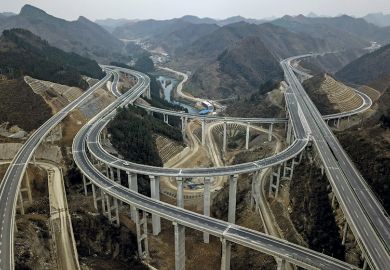This book – with its 225 plates – is certainly gorgeous. It is also deeply learned. The editors curate the almost 30,000 objects in Chicago’s Field Museum, which holds agricultural remains dating from earlier than 10,000 years BC, and precious treasures loved by emperors and learned connoisseurs. Visitors to the museum, dazzled by what they see, probably form convictions about the cultural identity of this material, namely its “Chineseness”. As I have studied China since 1954, I, too, have accumulated impressions about its long past and identity. But those who read this book will find much to learn – and their visions will change, as have mine.
The evidence that the editors present results from decades of archaeological research in China and in the museum, including their own work. Only skilled professionals, for example, could identify “hominids” of 500,000 years ago who were “much smarter than their primitive appearance might indicate”, used fire and made the tools exhibited at the museum.
In my graduate years, I learned what most Chinese also learned and many still believe: that what we call China – small and then larger agricultural communities – grew up in the north-east. Yet it is now plain that these developments happened in a broader geographical area, and that agriculture and the domestication of dogs, pigs – even voles – was not the result of cultural ingenuity but a response to climate change and flooding.
Take the Bronze Age. As a precious metal, bronze was used by the elite for ceremonial purposes such as feasting and rituals. Humbler people used tin and lead. But what is significant is that bronze manufacture emerged in various urban centres, along with writing and advanced tool making. Some of the earliest bronze objects are very beautiful, but how much more meaningful they appear when we learn, from this book, how they came to be and from where.
Who could not love this poem about hunting, translated by one of the curators? It was cut into stone tablets in the 7th century BC, in the region from which a unified China would emerge in the 3rd century AD, and incorporates characters still used ceremonially: “The lords’ sons are going to hunt… I drive the bucks among them. They are coming, pounding pounding. Scamper scamper. Gallop gallop. Now we’re driving. Now we’re waiting. The hinds and deer are so frenzied. They are coming in a rush.”
In China, new ideas tended to appear in times of crisis, as did Communism in the early 1920s. There are lovely Buddhist objects in the museum. Buddhism, we learn here, took hold in the 3rd century, “when the imperial Han Confucian order seemed to have failed so cataclysmically that people...were open to a more powerful foreign system of cosmology and salvation”. The Chinese version of Buddhism was then exported, sometimes in the cargoes of early ships, of which the museum has a collection.
The only serious mistake in this book is the statement that the Tang dynasty (618-906) was unified for almost 300 years. Actually, it began to collapse as an imperial whole from 755, when non-Han generals took over the north, driving a weakened Tang court to the south.
On a personal note, C. Martin Wilbur, a former curator at the museum, pictured in the book, recruited me (unknowingly) in 1958 into a CIA front in Taiwan.
Jonathan Mirsky was formerly associate professor of Chinese history and comparative literature at Dartmouth College in the US.
China: Visions Through the Ages
Edited by Lisa C. Niziolek, Deborah A. Bekken and Gary Feinman
University of Chicago Press
354 pages, £34.00
ISBN 9780226385372
Published 23 February 2018
POSTSCRIPT:
Print headline: Bronze, beasts and Buddhism
Register to continue
Why register?
- Registration is free and only takes a moment
- Once registered, you can read 3 articles a month
- Sign up for our newsletter
Subscribe
Or subscribe for unlimited access to:
- Unlimited access to news, views, insights & reviews
- Digital editions
- Digital access to THE’s university and college rankings analysis
Already registered or a current subscriber?








